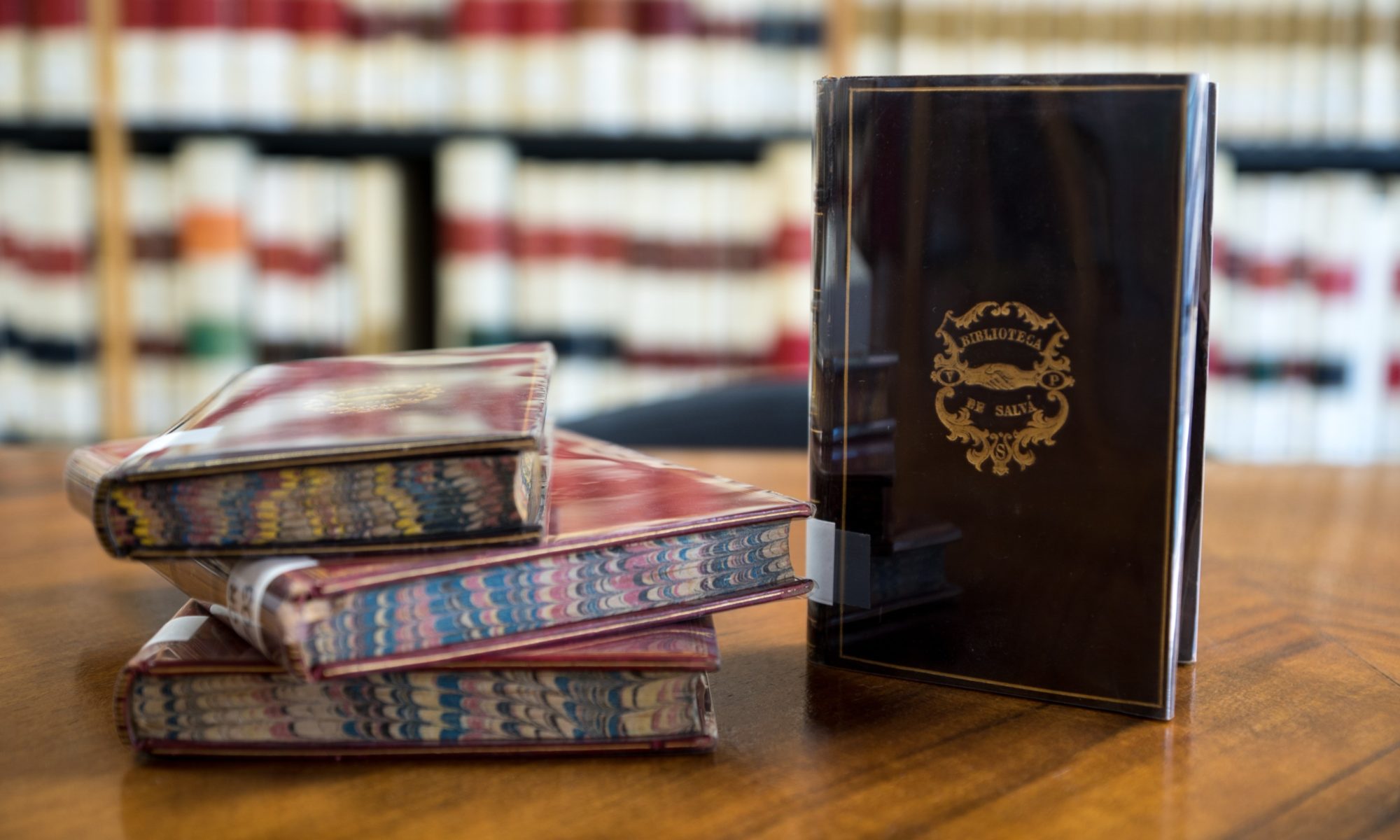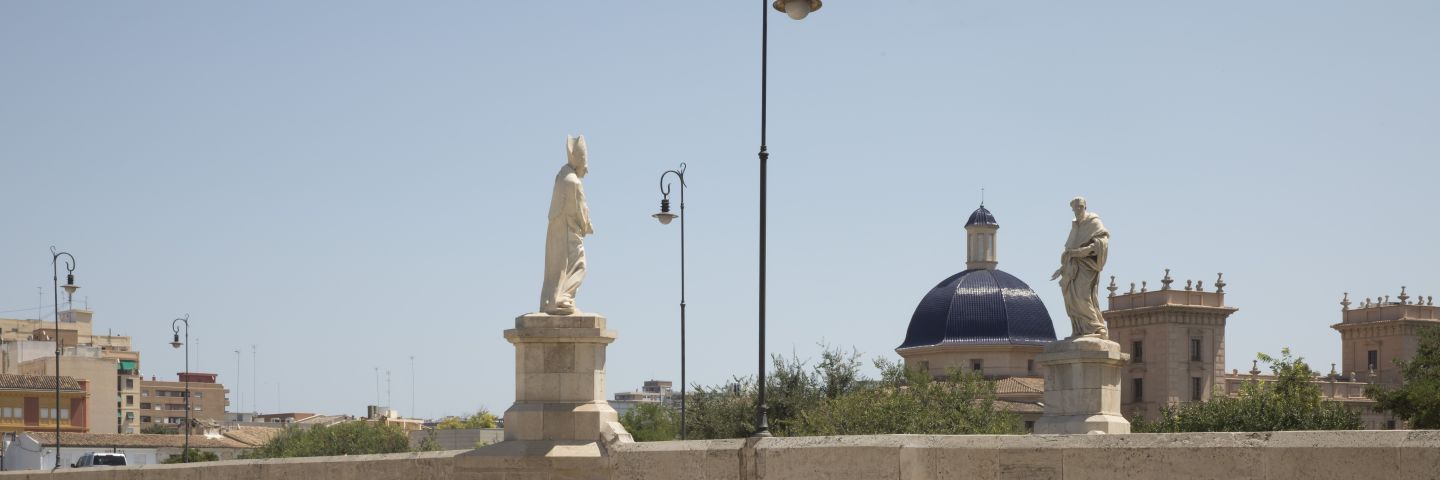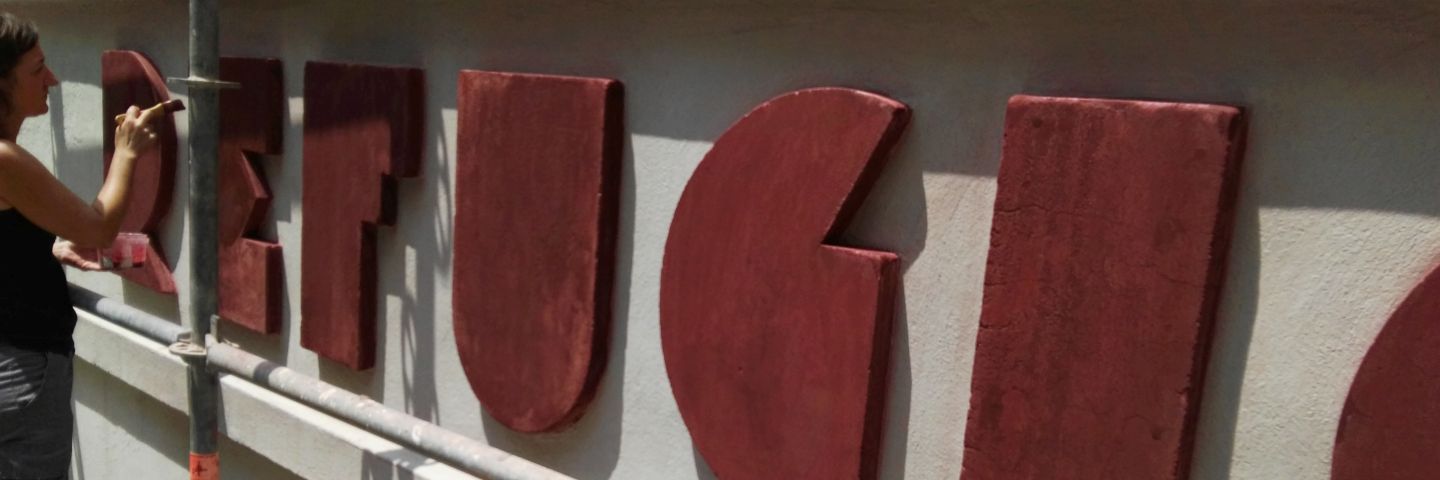
On the site of the old convent of Barefoot Augustinians and taking advantage in part of the previous work, is this charity establishment by the nuns of the Order of the religious Congregation of Little Sisters of Forsaken Elderly, founded by Maria Teresa de Jesús Jornet i Ibars, canonized on January 27, 1974. Architect, José Camaña Laymon (1850-1926).
In the building we must point out two old cloisters with semicircular arcades, centered by two modern images of the Heart of Jesus (from 1935) in the cloister on the right, and the Heart of Mary (from 1947), on the left, cloisters that were from the aforementioned convent of Discalced Augustinians. Also noteworthy is the neo-Gothic church from 1915 with an elongated nave of ten very oblong sections, 3 included in the choir and three more in the presbytery. The simple crossings; with squishy accessories. To this nave fall as triforium arches with lattices and the side chapels joined by one, not practicable by narrow, pointed opening, which simulates a aisle. In the last “chapel” of the old “Epistle” side next to the presbytery, the urn, also neo-Gothic, with the remains of Santa María Teresa Jornet, effigated to the sculptural monument of the nearby square that is related separately, the work of M. Silvestre “d’Edeta”.
Neo-Gothic church, treated in a very orthodox way, without any concessions to modernism. Designed by Joaquín María Arnau Miramón and finished by Francisco Almenar Quinzá. With a Latin cross floor plan, it has an atrium, five naves, transept, four chapels on each side and an apse with an ambulatory The structure has pointed central arches which, starting on pilasters of bundles of attached columns, discharge into those of the side naves and outer buttresses. The dome has an octagonal floor plan and in the shells there are monumental sculptures of Dominican popes. The façade has towers crowned with openwork spires and in the central body, pointed portal and large rose window. It is ornamented with stained glass windows by Maumejean.
Designed by the architect Francisco Mora Berenguer in 1907, the Sant Joan de Déu Hospital-Asylum responds to a new hygienist conception that is reflected in the open layout of the building with large galleries and terraces to take advantage of the benefits of the sun and the sea breeze.
It was originally built for the religious of the Order, traditionally dedicated to the care of the poor and sick, but specialized in the care of scrofulous and disabled children, and is today a modern hospital. The general floor plan of the building adopts a symmetrical arrangement based on a central body of greater height and two lateral wings that arise perpendicular from its ends. The construction makes abundant use of the tile used with austerity criteria that only vary in the upper part of the central body where it formalizes a neomudy cut finish. It is currently the Hospital de la Malvarrosa
It houses the Provincial Public Library (dependent on the Ministry of Culture and Education and the CEE Eurolibrary (legislation, etc.). In the Middle Ages the city of Valencia had numerous hospitals of modest capacity founded by pious bourgeois for the relief of the poor and sick. In 1512 a sentence of Ferdinand the Catholic decreed the unification of all these hospitals, creating the General Hospital of Valencia, which would be built on the old asylum or Hospital of Innocents.
Work of the architect Manuel Peris Ferrando, attached to a native modernism, more for its naturalistic decoration than for its typological structure. On the ground floor it is located, with baroque door and a chapel of San Valero. Apart from the decoration, the change of mentality of the time is shown; It is no longer an attic apartment with uncomfortable access without elevator, it is the floor where there is more light and more air.
The Municipal Library is an isolated building, with access through Plaza de Mainz, between the streets of Santa Cruz de Tenerife, Músico Ayllón, José Maestre and Llombai. It is a brick and cement construction , with functional character and simplicity, which contains the reading rooms, deposits or warehouses of books and related services. In his façade Its greatest artistic exponent is shown, which consists of four bronze statues, larger than the natural one, next to the access stairs, which represent the father Thomas Vicente Tosca, author of mathematical treatises, the layout of the University auditorium and the plan, or the plans, of the “Valentie Edetanorum”, so well known its original for its delineation, and which can be found in the Municipal Archive of the Town Hall. Its statue is the work of the sculptor Esteve Edo, at that time dean of the Faculty of Fine Arts.
The tangles of the Port of Valencia were built in 1914 by engineers José María Fuster and Fausto Élio. They formed part of the Port of Valencia Expansion and Improvement Plan, which aimed to relaunch the port of this city as an exporting power.
It is located, where at the beginning of the Reconquista there was a wooden bridge that served the Convent of Santo Domingo. After successive avenues of the River Turia, the old bridge deteriorated and, with the flood of 1517, was out of service.
In 1518 it was thought to build one in stone and with donations from the cemetery of the Convent of Santo Domingo, in 1595, the works began. Three years later, for the celebration of the wedding between Philip III and Queen Margaret, the bridge was finished. It was enlarged in 1967.
The Trinity Bridge is the oldest in the city. It was built between 1401 and 1407 in Gothic style by Matthew Texidor. It was also the first made of ashlar stone when it replaced the previous wooden bridge, although after the flood of 1517 it had to be partially rebuilt again.
It gets its name from its proximity to the Royal Monastery of the Holy Trinity, which is located a few meters away from its northern part.
It has a length of 158.31 meters and has 10 large pointed arches in Gothic style, as well as two stairs to go down and climb the bed of the river that were unused for quite some time until they were restored a few years ago.
The statues in charge of adorning the mansions, representing San Luis Bertrán and Santo Tomás de Villanueva, are by the Italian sculptor Jacobo Antonio Ponzanelli and were made at the end of the s. XVII. Until 1906 they were on the San Jose Bridge.
In the second decade of the twentieth century, engineers José María Fuster and Fausto Élio built six tangles, within the Plan for the Expansion and Improvement of the Port of Valencia, ordered by the Ministry of Public Works of the time, which sought to revitalize the export force of our port.
The Serrans Street Shelter was built in 1937 and had the capacity to accommodate 400 people. Its authorship is unknown.
Its function was to protect the population inside and cushion the impacts of the projectiles. For this, public centers, such as schools, and also private buildings were used.
The Plaza Redonda is one of Valencia’s great tourist attractions, one of those emblematic places in the city with which generations of Valencians identify.
It is a curious interior square of small dimensions, circular in shape, which has four entrances located at the cardinal points. Located in the old commercial area of the city, on an urban space linked since ancient times to the sale of fish and meat, it retained its function as a market.
It was built in 1840 by the architect Salvador Escrig, right in what was then the exact geometric center of the city. It is one of the smallest squares in Valencia, with a diameter of 37 meters.
The Plaza Redonda occupied the land of the old slaughterhouse, after its demolition. Formerly known as Plaça Nova or del Cid, later known as Plaça Redona or del Clot, it is located in the center of the triangle formed by Plaça del Mercat, Plaça de la Reina and Plaça de l’Ajuntament. It is surrounded by 34 buildings of different characteristics.











